Motorhome ownership gives you the fantastic opportunity to take to the road any time. Understanding motorhome weight and its implications is key to ensuring that each motorhome trip you take is as safe as it is enjoyable.
We’ve noticed that most first time buyers rarely consider motorhome weight. In our experience, their focus is on the layout and the more superficial aspects of the vehicle. However, buyers that return to purchase their second or third motorhome almost always have thought about the factors that influence how they can use their motorhome including weight. That’s usually because they have discovered that their first motorhome didn’t have sufficient payload to carry all the extras that they want to take with them.
We’ve created this article to help you understand why motorhome weight matters and how you can enjoy your motorhome while keeping its weight under the legal limits. In this article, we’ll explain weight terminology, help you understand how to factor weight into your motorhome purchase decision, give you tips on how to avoid overloading your motorhome, and show you how to increase your payload or carrying capacity.
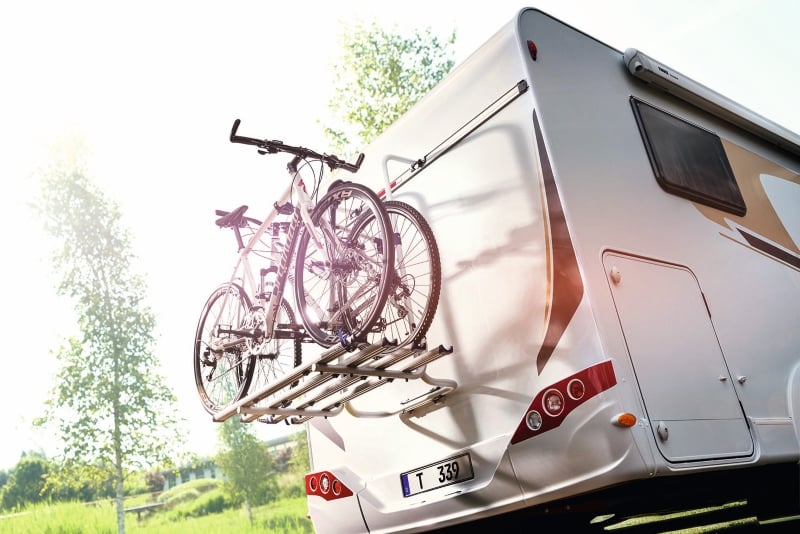
Understanding motorhome weight terminology
Unless you have experience in the trucking industry, you will probably be unfamiliar with much of the terminology relating to motorhome weight. Here are some key terms that you’ll hear about motorhome weight in New Zealand.
What is motorhome tare weight?
Tare weight is the weight of a motorhome with no load except for full fuel tanks. This includes empty water and waste tanks and no occupants or contents.
What is motorhome gross laden weight (GLW)?
Gross laden weight (GLW) is the weight of a motorhome with its load including full fuel tanks, water and waste tanks, occupants and contents.
What is motorhome gross vehicle mass (GVM)?
Gross vehicle mass (GVM) (also referred to as the gross vehicle weight or GVW) is the maximum operating weight of the motorhome as specified by the manufacturer.
What is motorhome gross combination mass (GCM)?
Gross combination mass (GCM) (also referred to as the gross combined weight or GCW) is the maximum combined weight (GVM) of the motorhome and the vehicle or trailer it is towing as specified by the manufacturer.
What is motorhome payload?
Payload is the weight added to the unladen motorhome, including occupants, water, wastewater, contents and accessories. The maximum payload is the GVM less the tare weight of the motorhome.
Where is the maximum loading weight information on a motorhome?
Important weights are recorded on plates/stickers in the motorhome. In most European motorhomes, these are the chassis rating plate and the chassis rating sticker. The chassis manufacturer attaches the chassis rating plate (which also includes the Vehicle Identification Number VIN) to the engine bay. This plate is also known as the stage 1 chassis rating plate..jpg?width=571&height=422&name=Chassis%20rating%20plate%20weights%20Carado%20800px%20(2).jpg)
Each time a vehicle undergoes a major modification, the chassis rating must be updated and a new chassis rating plate issued. In motorhome manufacturing, the addition of a habitation unit is known as the second stage of manufacturing (the cab and chassis construction is the first stage). New Zealand transport regulations require that any vehicle that has been modified and type certified to the European Community Whole Vehicle Type Approval (ECWVTA) system must have an ECWVTA Certificate of Conformity (CoC) and a corresponding label/plate on the vehicle. In most motorhomes, this is known as the Stage 2 (Stufe 2) chassis rating plate which is affixed to the driver’s door frame.
The loading weight information on the Stage 2 chassis rating sticker overrides the loading weight information on the Stage 1 sticker.
.jpg?width=843&height=412&name=Chassis%20rating%20sticker%20weights%20Carado%20800px%20(2).jpg)
Some motorhomes may also have a Stage 3 or even Stage 4 chassis rating plate. Stage 3 plates are common when the original chassis is replaced e.g. with an AL-KO chassis and Stage 4 plates may be issued when the motorhome has a GVM increase. These plates may be fixed to the motorhome in different places e.g. in the stairwell inside the habitation door entry or on the body of the motorhome behind the rear wheel.
The maximum loading weights are also in the motorhome manual supplied by the manufacturer or in manufacturer specifications online.
How do you read a chassis rating plate?
The chassis rating plates list the gross vehicle mass, gross combination mass and axle weight maximums of the motorhome. Axle weight maximums show how much weight each axle can support. The axle weight maximum values add up to more than GVM to allow for variations in loading.
Chassis rating plate example illustration from a Carado motorhome
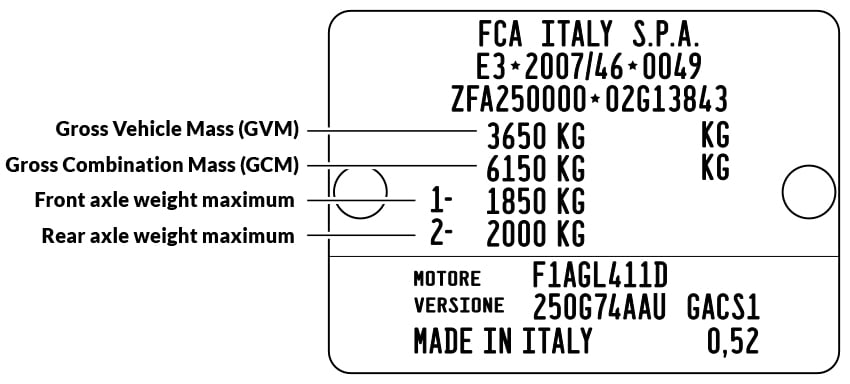
Stage 2 (Stufe 2) chassis rating plate example illustration from a Carado motorhome
How is a motorhome weighed?
A motorhome can be weighed on a weighbridge or by using portable scales. The weighbridge is the most accurate as it is designed to measure heavy items. Portable scales for motorhomes are also available. While these are handy and can be used anywhere, they may not be as accurate nor as readily available in New Zealand.
You can either weigh your motorhome fully loaded to get your GLW or remove your contents to get the tare weight. Also check how much weight is being supported by each axle to ensure the weights don’t exceed the maximum weights recommended by the manufacturer.
Remember to remove gear like bike racks and other removable items before weighing. Once you have your GLW or tare weight and individual axle weights, you can check these against your weight plates.
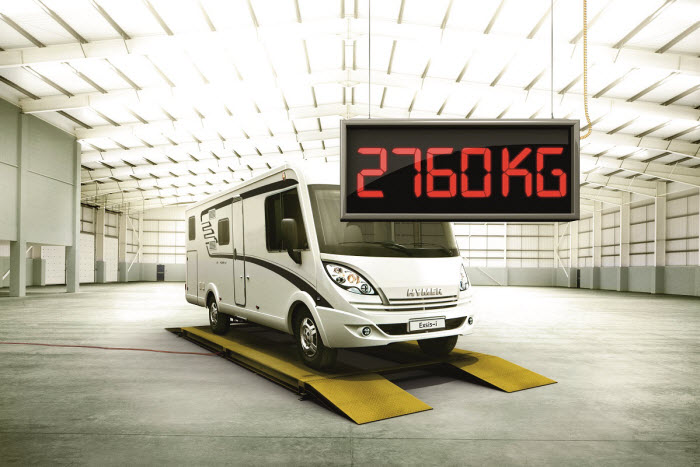
Considering motorhome weight before you purchase
If you haven’t yet purchased a motorhome, you’ll want to consider motorhome weights in your purchase decision. It’s better to think about this at the outset rather than get a surprise after you have purchased.
Like all things in the recreational vehicle market, managing motorhome weights is an exercise of trade offs. You can purchase a motorhome with a low GVM and a small payload and have lower compliance costs or you can purchase a motorhome with a higher GVM and higher payload but with higher compliance costs. Whichever decision you make, you’ll want to understand all the implications before you commit your hard earned dollars to a big purchase.
What build factors impact motorhome weight?
Several key factors in the build of a motorhome can affect its final weight. The most significant are chassis weight and habitation construction.
Chassis weight has the greatest bearing on motorhome weight
More motorhomes are built on a light chassis than a heavier chassis because of the lower cost of the light chassis. The tradeoff is that a light chassis can support less payload than a heavier chassis. Therefore, motorhome manufacturers pay considerable attention to habitation construction to reduce tare weight and optimise the payload on a light chassis.
As rear wheel drive chassis are heavier than front wheel drive chassis, motorhomes with real wheel drive will usually be heavier than the 3500kg GVM of a light motorhome.
Building light habitation units
The materials that manufacturers use for the frame and side and roof panels as well as floor materials also contribute to the motorhome’s weight. Improvements in the availability of high performance lightweight materials have enabled motorhome manufacturers to optimise durability, thermal properties, water tightness, interior noise and ease of maintenance while lowering the tare weight.
Modern motorhome habitation units are made from bonded laminates combined with foam which make a light, strong and waterproof unit. Aluminium and fibreglass are also used in the construction of the habitation area. These materials are both light and waterproof while also being strong and durable. Glass reinforced plastics (GRP) are used for roofs and floors. These protect from rough weather including hail storms and make floors more durable.
More water storage means more motorhome weight
Since every litre of water adds a kilogram of weight, how much water storage the motorhome has is a key variable that manufacturers consider. Most manufacturers who design motorhomes with a maximum 3500kg GVM limit the fresh water tank size to around 120 litres and waste water to around 90 litres. If more water storage is important to you, you will want to consider a motorhome with a higher GVM.
When reviewing the tare weights as payload weights supplied by the manufacturer, it’s important to note that they stipulate (in the fine print) that deviations within the factory tolerances are possible and permissible so you can’t take what you read as exact down to the last kilogram.
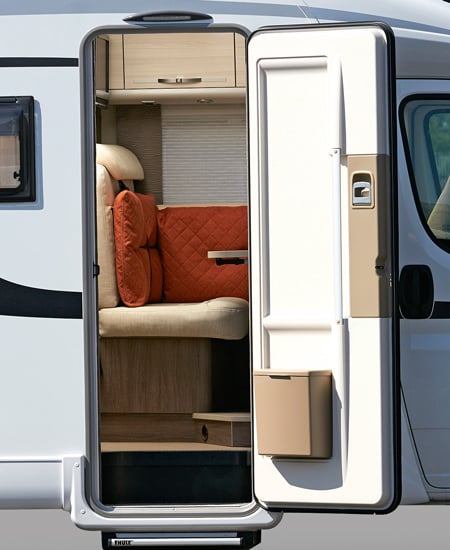
How do I avoid overloading my motorhome?
The best way to avoid overloading your motorhome is to be aware of your maximum payload and actively manage this. It’s important to check the tare weight and maximum payload of the motorhome before you purchase it and also before you decide what accessories you want to add.
The tare weight needs to be adjusted once modifications are made to the motorhome after it leaves the manufacturer. This includes installation of a tow bar, solar panels, extra batteries, satellite dish, bike racks and any other aftermarket additions. To determine whether you have sufficient allowance for payload, do a rough calculation of how much payload you think you will need. A good rule of thumb is to allow for 150 - 200kg per occupant including the weight of the occupants and the food, water and clothing they each need. Other gear and equipment like bikes are additional.
If the difference between the maximum payload in the motorhome you purchase and your estimated payload is small then you will need to carefully consider weight when you pack for each trip. Make sure you only pack the items you need for this specific trip. Just because you have the cupboard space doesn’t mean you have to fill it.
Weight can add up fast. Use the ready reckoner below to help estimate your payload.
Weight of common items taken on a motorhome trip
|
Item |
Approximate weight (kg) |
|
Fix&Go Tyre Kit |
2 |
|
TV |
3 |
|
Camping chair |
4 |
|
Golf clubs |
5 |
|
Camping table |
6 |
|
Bed linen for a double bed |
6 |
|
Portable barbeque |
8 |
|
Inflatable SUP |
9 |
|
Bike |
13 |
|
Fishing torpedo |
15 |
|
Electric bike |
23 |
|
Generator |
25 |
|
Extra battery |
25 |
|
Spare tyre |
25 |
|
Awning |
30 |
Record the actual weights of the items you typically pack as you go as this can help you avoid overloading your motorhome on future trips.
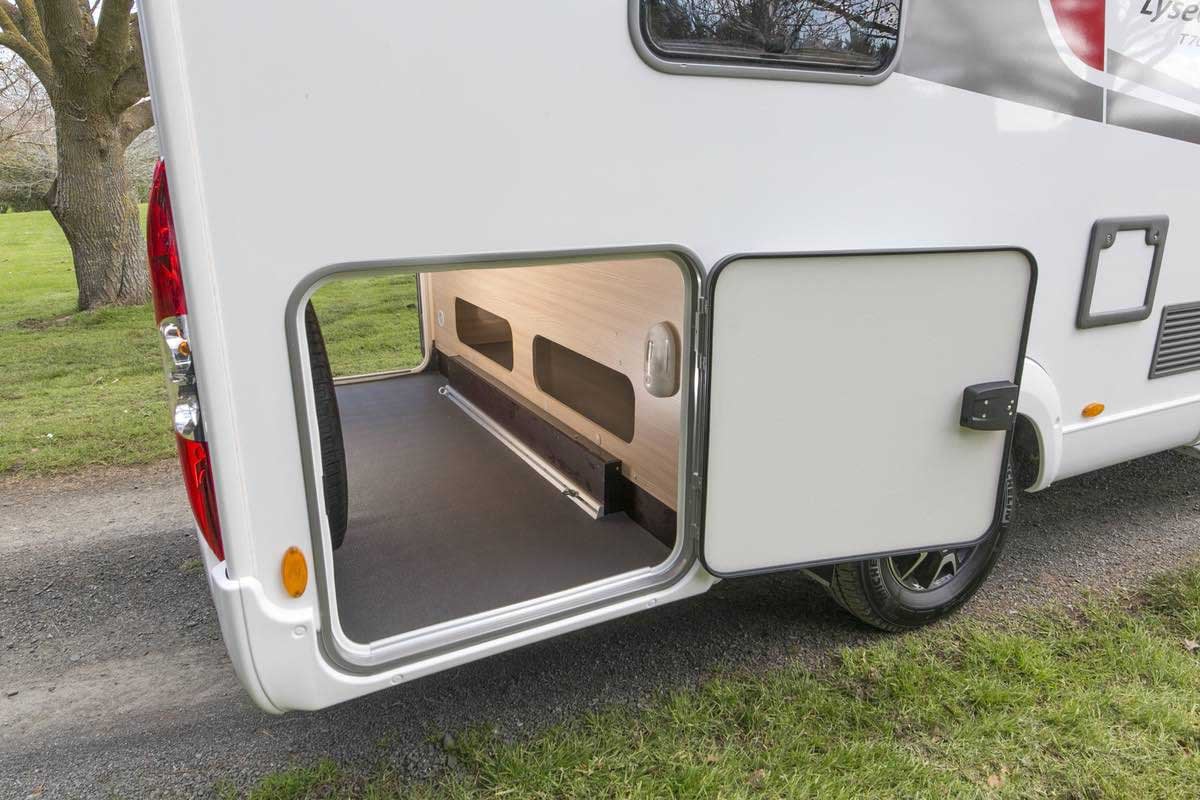
Spare tyre vs Fix&Go kit
A motorhome’s spare tyre is one of the heaviest additional items you’re likely to carry. One of the easiest ways to increase your payload up to 25kg is to leave your spare tyre at home and instead take a Fix&Go kit. These kits are designed to temporarily fix the most common tyre damage i.e. punctures and leaks. There’s no need to call a roadside assistance technician as you can undertake the simple repair yourself. The Fix&Go kit works by sealing the inside of the tyre. Unlike a space saver tyre in a car, a tyre repaired using a Fix&Go kit can drive at full speed (110km max) for another 1000km allowing you to get home in most cases. Then you can go to your local tyre shop for a permanent repair. All new Bürstner and Carado motorhomes supplied by Wilderness come with a Fix&Go kit.
How to correctly load your motorhome
Whether you can carry lots of gear or just a little, pay attention to how weight is distributed when loading your motorhome. Incorrect loading can put strain on tyres, affect braking and stopping distances as well as motorhome handling.
Pack heavy items low to the ground in the garage and underfloor storage compartments wherever possible. Lighter items can be stowed up higher but ensure that any storage compartment is securely closed after packing.
While the rear of motorhomes can have plenty of room for gear, take care not to overload this space. Too much weight at the rear axle can affect the handling and lead to a snaking effect when changing lanes or overtaking. Loading your motorhome with weight evenly distributed across all axles is ideal.
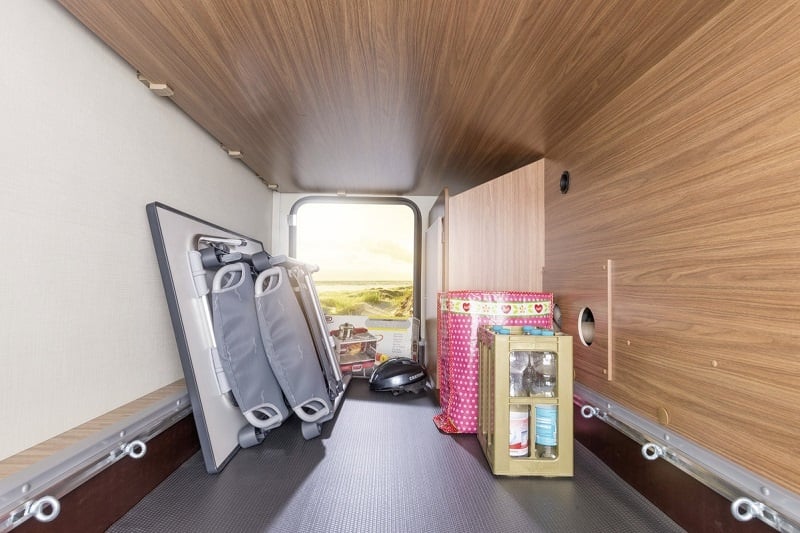
How does the GVM of a motorhome affect its owner?
After you have determined the weight of all the contents you wish to carry, you may conclude that you will need a heavy motorhome with a higher GVM to get the amount of payload you require. While a heavy motorhome will usually give you more payload than a lighter one, there are a few other factors to keep in mind. The GVM of a motorhome has an impact on maximum road speed, the applicable vehicle testing regime, towing requirements, driver licencing rules, and road user charges. Light motorhomes (with a GVM of 3500kg or less) can be driven on the roads at the same speed as a standard car, whereas heavy motorhomes (with a GVM of more than 3500kg) are restricted to 90km. A Warrant of Fitness (WoF) is required for light motorhomes while heavy motorhomes need a Certificate of Fitness (CoF). CoF inspections cost twice as much and take longer to complete compared with a WoF. Motorhomes on a CoF also require inspection every six months as opposed to every year for a WoF.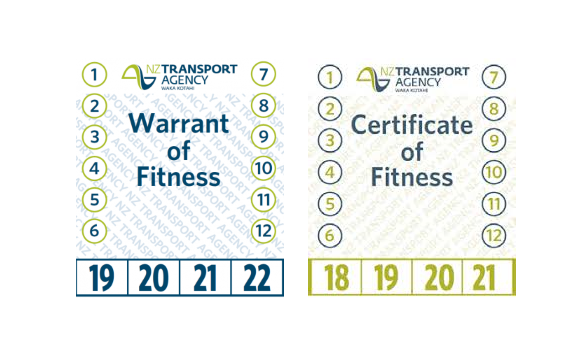
Light motorhomes don’t have any specific towing requirements compared to heavy motorhomes which require the towing connection to be certified by a heavy vehicle specialist certifier.
License requirements also vary depending on GVM. Heavy motorhomes with a GVM of more than 6000kg require a Class 2 driver’s licence while those above 25,000kg require a Class 4.
Road User Charges (RUC) rates also vary depending on the GVM and heavy motorhomes will also require the installation of a hubodometer.
How do you increase the maximum loading weight of your motorhome?
If your motorhome GVM is insufficient to allow you to bring all your gear, you can increase the GVM with the help of a motorhome uprating specialist. The process involves an initial assessment of your motorhome including axle components to ensure each part of the axle can handle the new loading weight. Additional suspension components are then added to the motorhome which allow it to support the additional weight. Some parts of the axle may need to be replaced to achieve the highest GVM. In addition to increased carrying capacity, an uprated suspension also has the advantage of a smoother ride for many motorhomes.

Motorhome loading weight is crucial to consider before buying a new motorhome. The GVM should suit your specific needs giving you sufficient payload to be safe and within legal limits. Although you can increase the maximum loading weight of your motorhome after purchase by uprating the suspension, the simplest and less expensive option is to choose a motorhome with a generous weight allowance for all your gear at the outset.
Most motorhome owners choose to trade off the payload benefits of a heavy motorhome for the lower cost light motorhome with a smaller payload. This means that payload has to be carefully managed to stay within the permissible limits and ensure that the motorhome handles safely. It’s a good idea to know the tare weight and payload of your motorhome and how much weight you are carrying before you set off on a trip.
Now that you’re armed with all the information on motorhome weight and payload, you’re ready to safely set off on your next motorhome adventure.


